Demand Management for Resilience Enhancement of Integrated Energy Distribution System against Natural Disasters
Abstract
:1. Introduction
2. The Demand Management Strategy for the IEDS under Natural Disasters
2.1. The Type of Natural Disasters
2.2. The Fragility Curves and Stochastic Approaches
2.3. The Framework of the Demand Management Strategy
3. Model Formulation
3.1. Objective Function
3.2. The Power Distribution System Constraints
3.3. The Gas Distribution System Constraints
3.4. The District Heating System Constraints
4. Numerical Results
4.1. The Operation of IEDS
4.2. The Importance Ranking of Transmission Lines and Pipelines
4.3. The Electrical Resilience Mode and Integrated Resilience Mode
4.4. The Demand Management Strategy
5. Conclusions
Author Contributions
Funding
Institutional Review Board Statement
Informed Consent Statement
Data Availability Statement
Conflicts of Interest
Appendix
| Indices and Sets | |
| t | Index of hours running from 1 to T. |
| s | Index of scenarios running from 1 to . |
| b | Index of buses running from 1 to . |
| n | Index of nodes running from 1 to . |
| Index of power/natural gas purchase points. | |
| Index of overhead transmission line start/end points. | |
| Index of overhead transmission line end/start points corresponding to . | |
| Index of gas pipeline start/end points. | |
| Index of gas pipeline end/start points corresponding to . | |
| Index of wind generators. | |
| Index of CHP units/electrical heat pumps/boilers. | |
| Set of power/natural gas purchase points. | |
| Set of overhead transmission line start/end points. | |
| Set of adjacent buses. | |
| Set of gas pipeline start/end points. | |
| Set of adjacent nodes. | |
| Set of access points of CHP units in power/gas distribution system. | |
| Set of access points of electrical heat pumps/boilers/wind generators. | |
| Parameters | |
| T | Duration of scheduling horizon. |
| Number of scenarios. | |
| Number of buses | |
| Number of nodes | |
| Probability of scenarios s. | |
| Active power/reactive power/natural gas price at hour t. | |
| Cost of reactive power from CHP units . | |
| Subsidy cost of active power/reactive power/natural gas/heat load demand response. | |
| Penalty cost of wind generator power curtailment. | |
| / | Active power load/reactive power load at bus b in Scenarios s at hour t. |
| Natural gas load at node n in Scenarios s at hour t. | |
| Heat load in Scenarios s at hour t. | |
| Resistance/reactance of overhead transmission line ij. | |
| Base value of voltage. | |
| Maximum active/reactive power of overhead transmission line ij. | |
| Maximum active/reactive power purchased from IEDS. | |
| Maximum/minimum voltage at bus b. | |
| Forecasted output of wind generator in Scenarios s at hour t. | |
| Power factor of wind generator . | |
| Gas flow constant of gas pipeline ij. | |
| Direction coefficient of gas flow in gas pipeline ij. | |
| Maximum natural gas flow of gas pipeline ij. | |
| Maximum natural gas purchased from IEDS. | |
| Maximum/minimum pressure at node n. | |
| M | Sufficiently big number |
| Abscissa breakpoints of domain | |
| Ordinate value corresponding to | |
| Size/number of interval. | |
| Maximum/minimum active power output of CHP units . | |
| Maximum/minimum reactive power output of CHP units . | |
| Electrical/heat efficiency of CHP units . | |
| Maximum power/gas consumption of EHP /boiler . | |
| Heat efficiency of EHP/boiler . | |
| Variables | |
| Active power/reactive power/natural gas purchased from IEDS in scenarios s at hour t. | |
| Active power/reactive power/natural gas/heat load demand response at bus b/at node n in Scenarios s at hour t. | |
| Power curtailment of wind generator in Scenarios s at hour t. | |
| / | Scheduled active/reactive power output of wind generator in Scenarios s at hour t. |
| Scheduled reactive power output of wind generator in Scenarios s at hour t. | |
| Active power/reactive power of CHP unit in Scenarios s at hour t. | |
| Power consumption of electrical heat pump in Scenarios s at hour t. | |
| Active power/reactive power of overhead transmission line ij in Scenarios s at hour t. | |
| Voltage at overhead transmission line start/end point in Scenarios s at hour t. | |
| Voltage at bus b in Scenarios s at hour t. | |
| Gas consumption of CHP unit in Scenarios s at hour t. | |
| Gas consumption of boiler in Scenarios s at hour t. | |
| Natural gas flow of gas pipeline ij in Scenarios s at hour t. | |
| Gas pressure at gas pipeline start/end point in Scenarios s at hour t. | |
| Gas pressure at node n in Scenarios s at hour t. | |
| Binary variable of gas flow direction of gas pipeline ij in Scenarios s at hour t. | |
| Gas pressure square at gas pipeline start/end point in Scenarios s at hour t. | |
| Auxiliary continuous/binary variable at kth interval of gas pipeline ij in Scenarios s at hour t. | |
| heat output of CHP unit in Scenarios s at hour t. | |
| Heat output of electrical heat pump in Scenarios s at hour t. | |
| Heat output of boiler in Scenarios s at hour t. | |
References
- Wang, S.; Li, Y.; Haque, M. Evidence on the Impact of Winter Heating Policy on Air Pollution and Its Dynamic Changes in North China. Sustainability 2019, 11, 2728. [Google Scholar] [CrossRef] [Green Version]
- Rashid, L.; Lin, L. Foreign Direct Investment in the Power and Energy Sector, Energy Consumption, and Economic Growth: Empirical Evidence from Pakistan. Sustainability 2019, 11, 192. [Google Scholar]
- Ye, J.; Yuan, R. Integrated Natural Gas, Heat, and Power Dispatch Considering Wind Power and Power-to-Gas. Sustainability 2018, 9, 602. [Google Scholar] [CrossRef] [Green Version]
- Wu, J.; Yan, J.; Jia, H. Integrated Energy Systems. Applied Energy 2016, 167, 155–157. [Google Scholar] [CrossRef]
- Marnay, C.; Aki, H.; Hirose, K.; Kwasinski, A.; Ogura, S.; Shinji, T. Japan’s Pivot to Resilience: How Two Microgrids Fared after the 2011 Earthquake. IEEE Power Energy Mag. 2015, 13, 44–57. [Google Scholar] [CrossRef]
- Che, L.; Khodayar, M.; Shahidehpour, M. Only Connect: Microgrids for Distribution System Restoration. IEEE Power Energy Mag. 2014, 12, 70–81. [Google Scholar]
- Bie, Z.; Lin, Y.; Li, G. Battling the Extreme: A Study on the Power System Resilience. Proc. of the IEEE 2017, 105, 1253–1266. [Google Scholar] [CrossRef]
- Mathaios, P.; Pierluigi, M. Modeling and Evaluating the Resilience of Critical Electrical Power Infrastructure to Extreme Weather Events. IEEE Systems Journal 2017, 11, 1733–1742. [Google Scholar]
- Lei, S.; Wang, J.; Chen, C.; Hou, Y. Mobile Emergency Generator Pre-Positioning and Real-Time Allocation for Resilient Response to Natural Disasters. IEEE Trans. Smart Grid 2018, 9, 2030–2041. [Google Scholar] [CrossRef] [Green Version]
- Wang, Z.; Chen, B.; Wang, J.; Chen, C. Networked Microgrids for Self-Healing Power Systems. IEEE Trans. Smart Grid 2016, 7, 310–319. [Google Scholar] [CrossRef]
- Sergio, F.; Desta, Z.; Marco, R.; Carlos, M. Impacts of Optimal Energy Storage Deployment and Network Reconfiguration on Renewable Integration Level in Distribution Systems. Appl. Energy 2017, 185, 44–55. [Google Scholar]
- Abdullahi, M.; Li, Y.; Stewart, M. Evaluating System Reliability and Targeted Hardening Strategies of Power Distribution Systems Subjected to Hurricanes. Reliab. Eng. Syst. Saf. 2015, 144, 319–333. [Google Scholar]
- Lin, Y.; Bie, Z. Tri-level Optimal Hardening Plan for a Resilient Distribution System Considering Reconfiguration and DG Islanding. Applied Energy 2018, 210, 1266–1279. [Google Scholar] [CrossRef]
- Shao, C.; Shahidepour, M.; Wang, X.; Wang, X.; Wang, B. Integrated Planning of Electricity and Natural Gas Transportation Systems for Enhancing the Power Grid Resilience. IEEE Trans. Power Syst. 2017, 32, 4418–4429. [Google Scholar] [CrossRef]
- Cong, H.; He, Y.; Wang, X.; Jiang, C. Robust Optimization for Improving Resilience of Integrated Energy Systems with Electricity and Natural Gas Infrastructures. J. Mod. Power Syst. Clean Energy 2018, 6, 1066–1078. [Google Scholar] [CrossRef] [Green Version]
- Amin, S.; Ali, R. An Integrated Steady-State Operation Assessment of Electrical. Natural Gas, and District Heating Networks. IEEE Trans. Power Syst. 2016, 31, 3636–3647. [Google Scholar]
- Long, R.; Liu, J.; Shi, J.; Zhang, J. Coordinated Optimal Operation Method of the Regional Energy Internet. Sustainability 2017, 9, 848. [Google Scholar] [CrossRef] [Green Version]
- Yao, L.; Wang, X.; Qian, T.; Qi, S.; Zhu, C. Robust Day-Ahead Scheduling of Electricity and Natural Gas Systems via a Risk-Averse Adjustable Uncertainty Set Approach. Sustainability 2018, 11, 3848. [Google Scholar] [CrossRef] [Green Version]
- Carlos, M.; Pedro, S. Integrated Power and Natural Gas Model for Energy Adequacy in Short-Term Operation. IEEE Trans. Power Syst. 2015, 30, 3347–3355. [Google Scholar]
- Dupacová, J.; GroWe-Kuska, N.; RoMisch, W. Scenario Reduction in Stochastic Programming an Approach Using Probability Metrics. Mathe. Program. 2003, 3, 493–511. [Google Scholar] [CrossRef]
- Ding, T.; Lin, Y.; Li, G.; Bie, Z. A New Model for Resilient Distribution Systems by Microgrids Formation. IEEE Trans. Power Syst. 2017, 32, 4145–4147. [Google Scholar] [CrossRef]
- He, C.; Wu, L.; Liu, T.; Shahidehpour, M. Robust Co-Optimization Scheduling of Electricity and Natural Gas Systems via ADMM. IEEE Trans. Sustain. Energy 2017, 8, 658–670. [Google Scholar] [CrossRef]

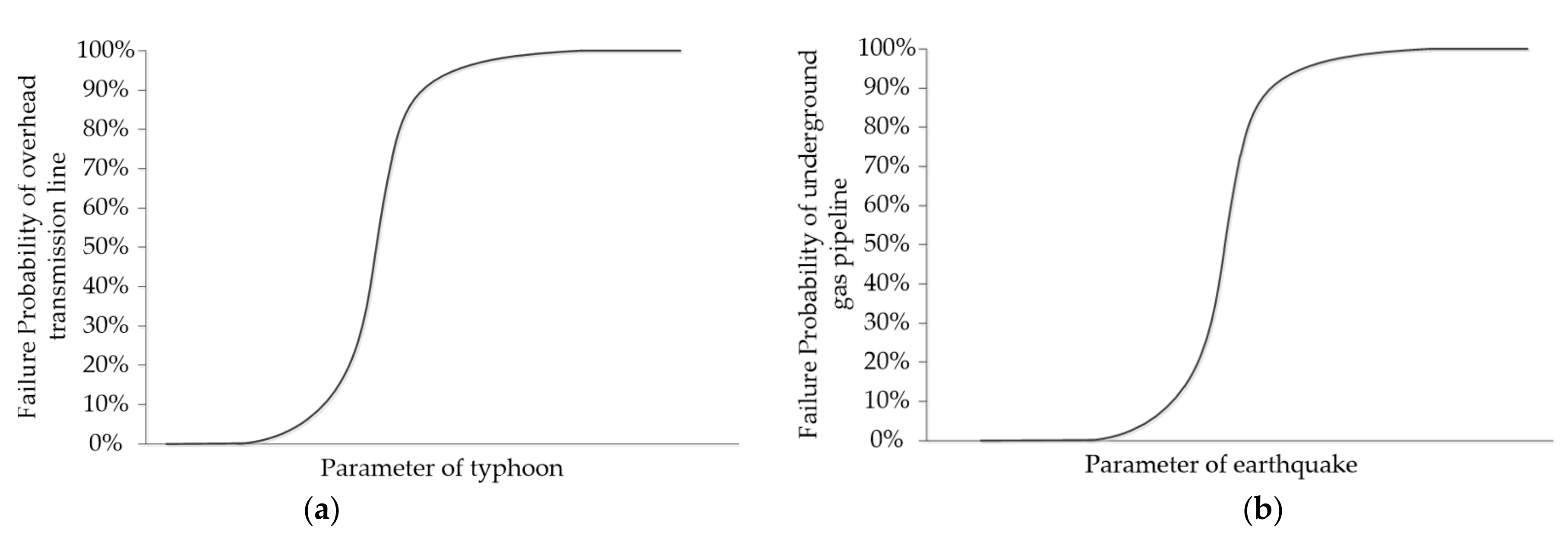
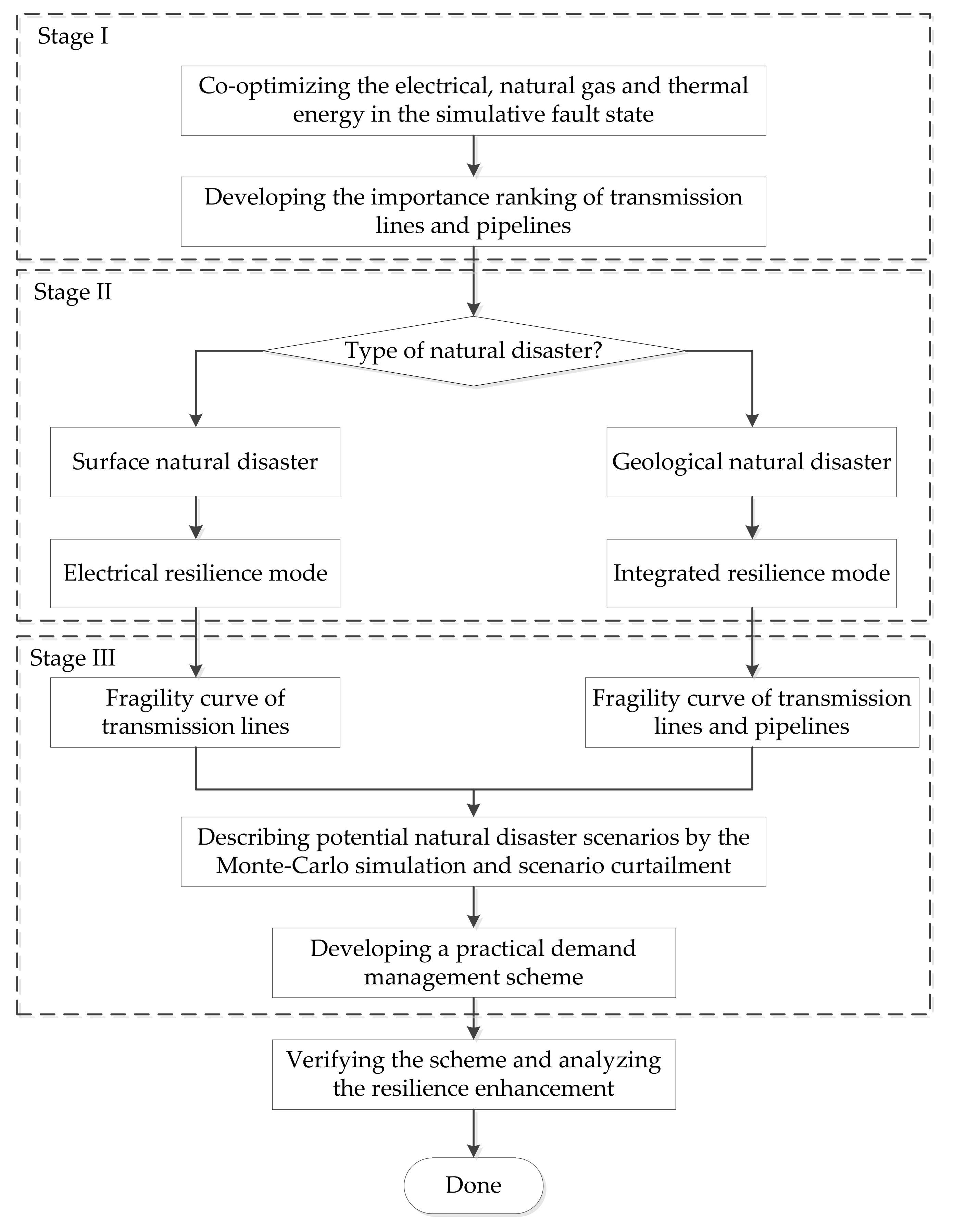
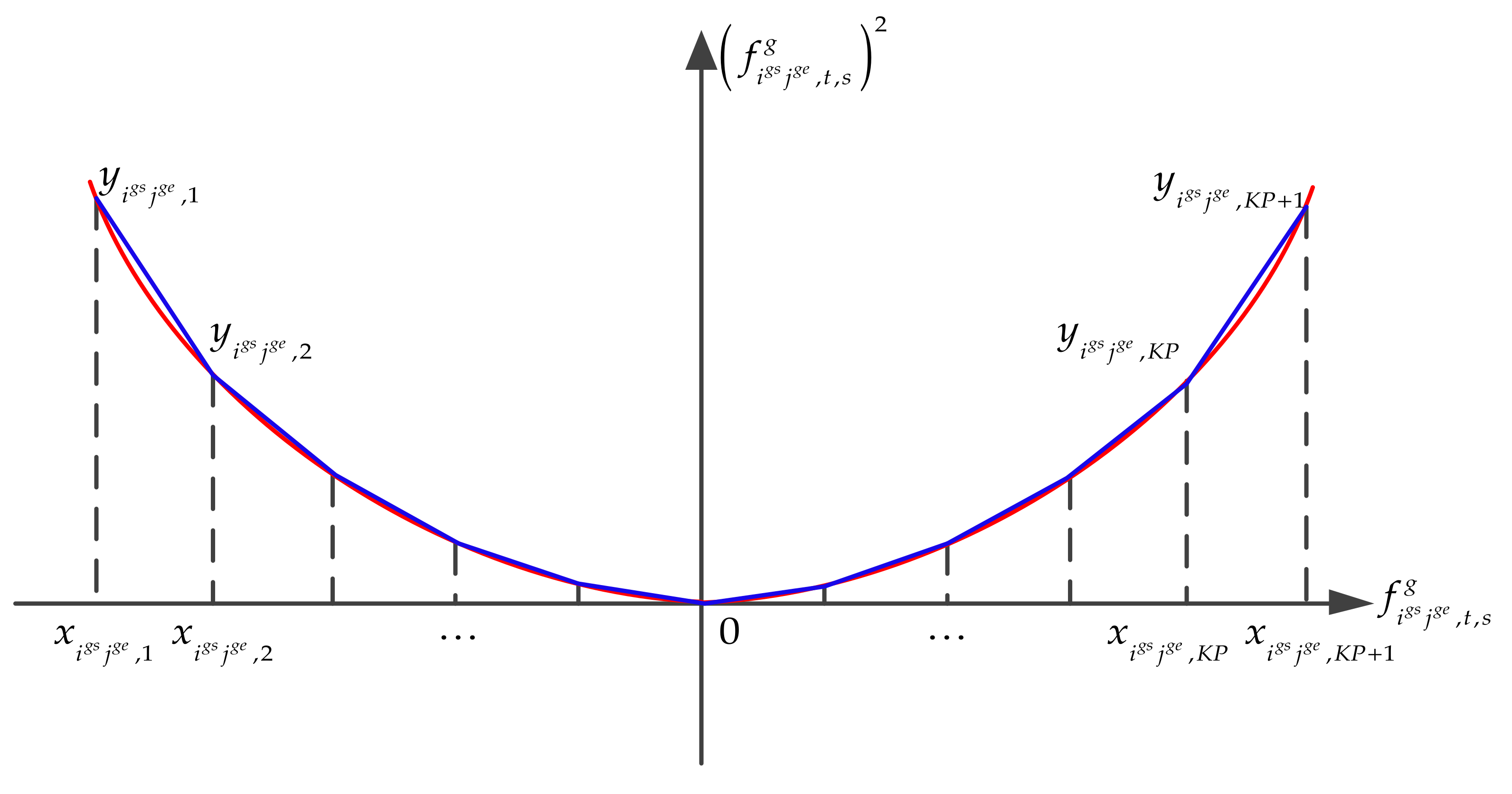

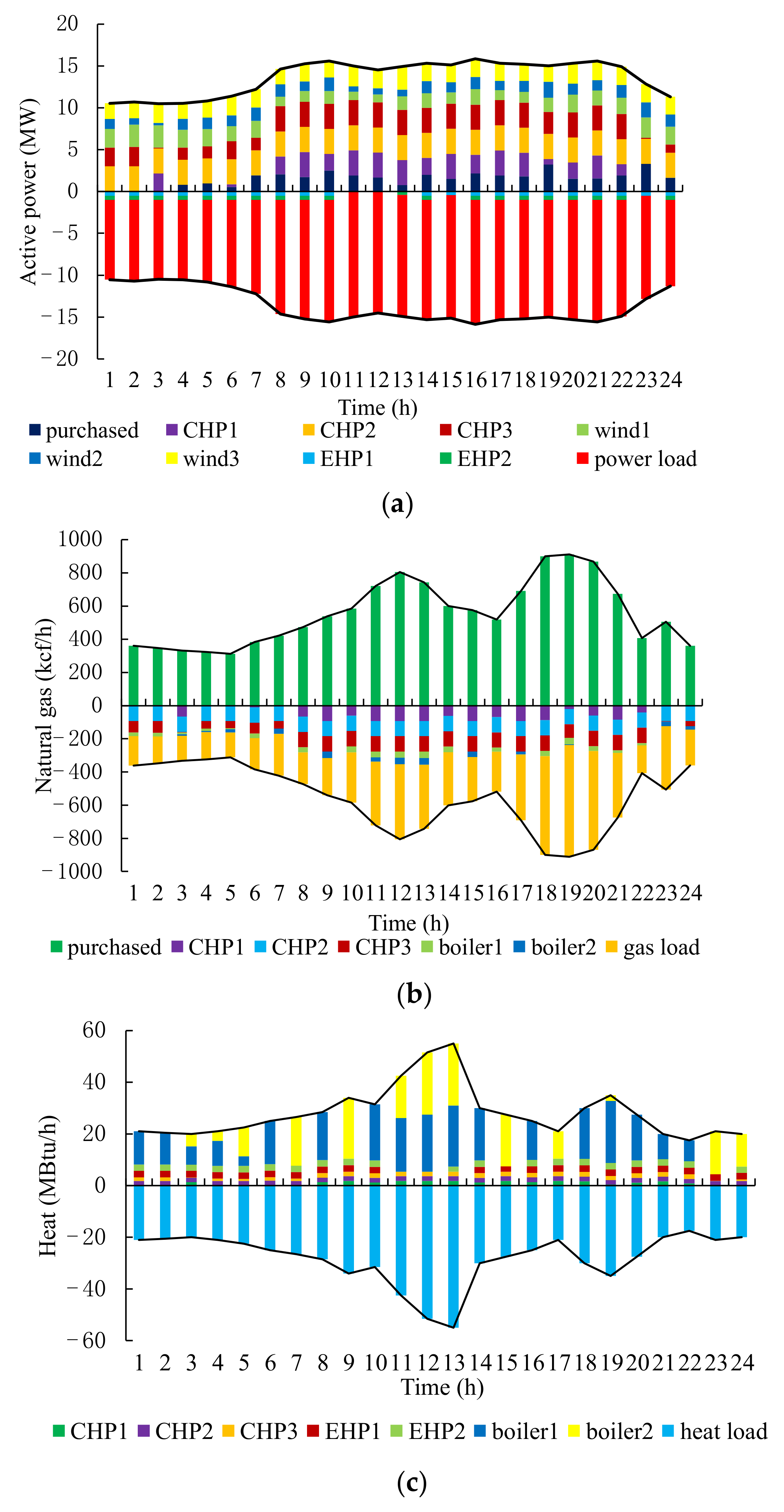
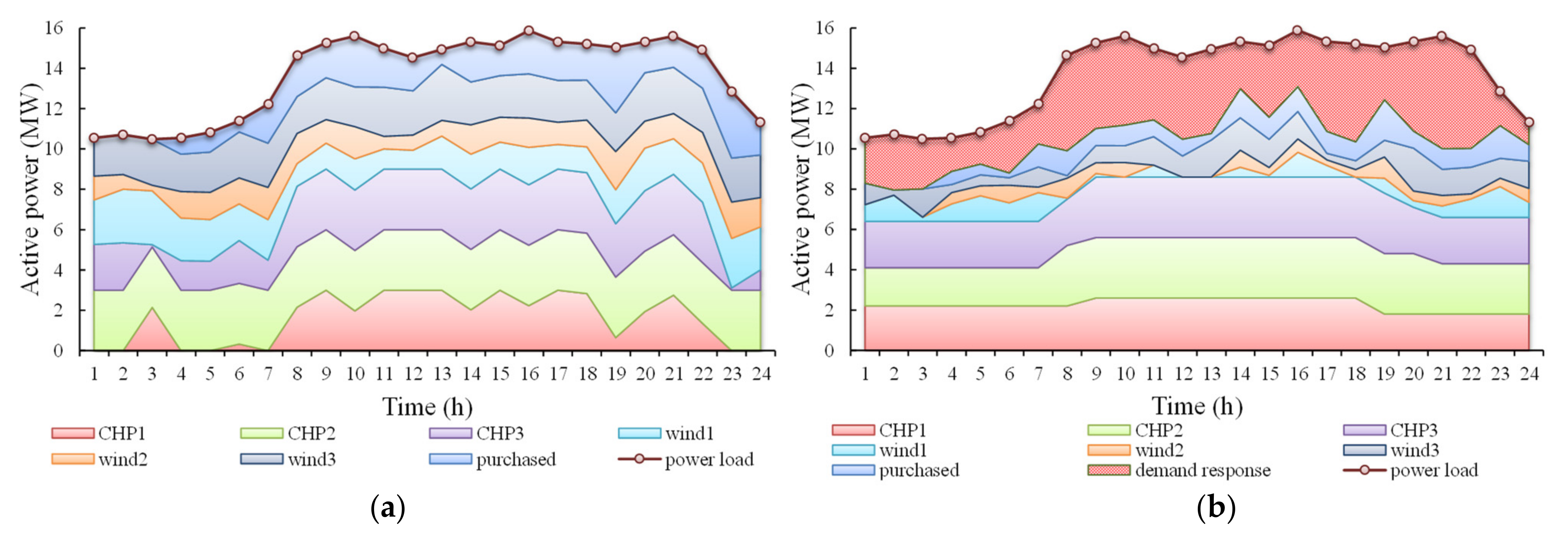
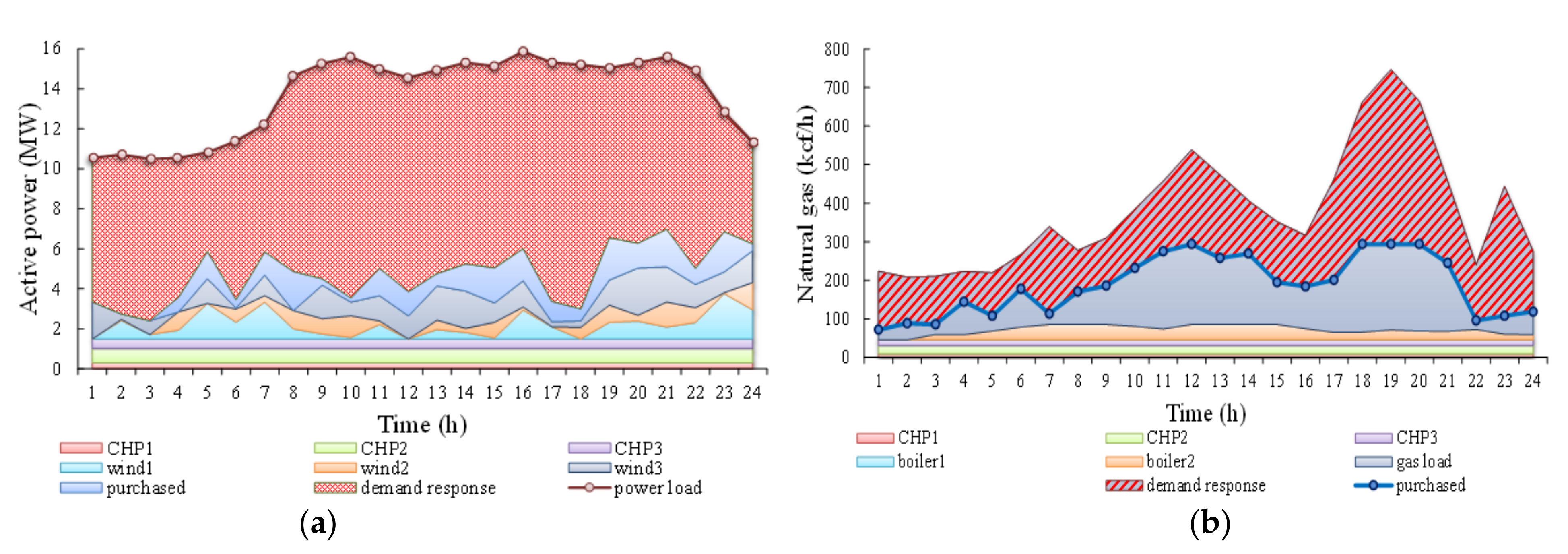
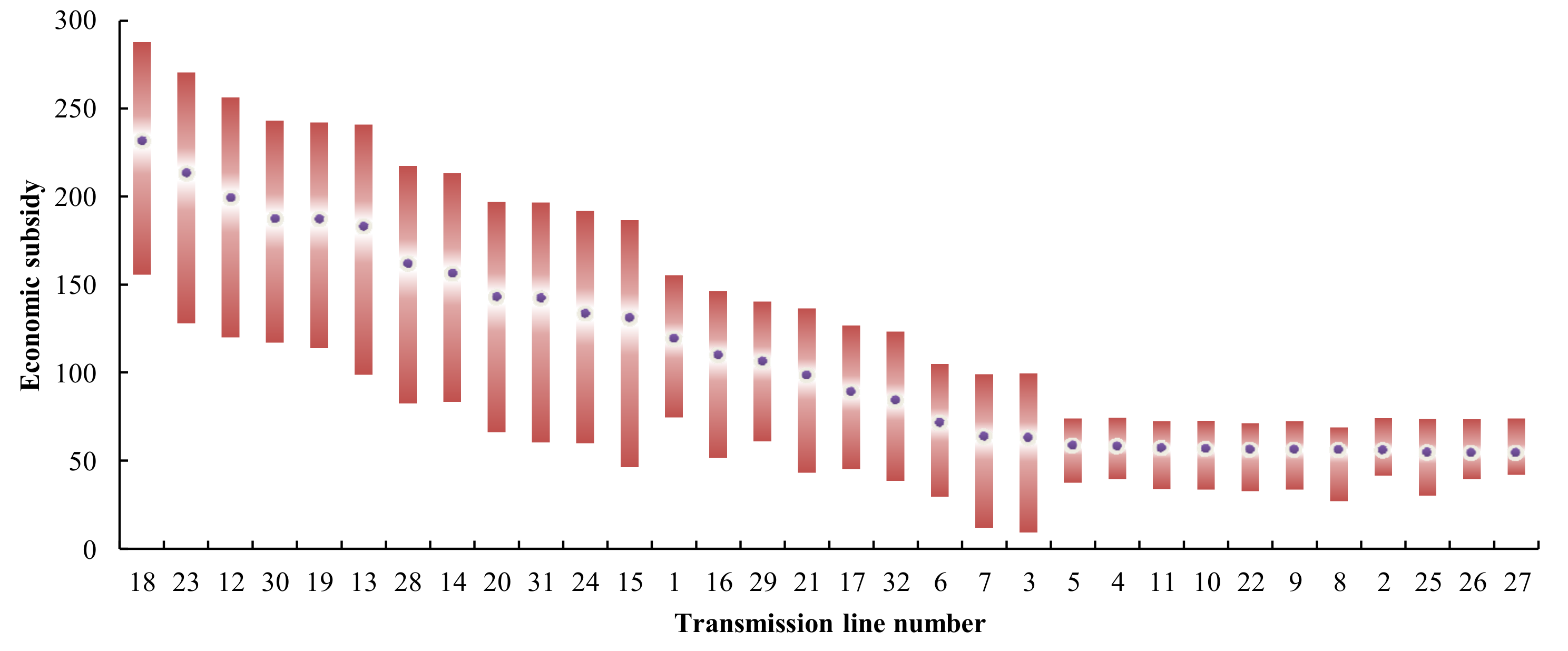

| System Types | References | Enhanced Resilience Methods |
|---|---|---|
| Power system | [9] | Scheduling flexible back-up resources |
| [10] | Decentralized control strategy for MGs | |
| [11] | Grid reconfiguration | |
| [12] | Enhancing infrastructure | |
| [13] | ||
| Integrated energy system | [14] | Enhancing infrastructure |
| [15] | ||
| This paper | Demand management |
| A | 232.1 K | 213.7 K | 199.5 K | 187.7 K | 187.5 K | 183.2 K | 162.0 K | 156.4 K | 143.0 K | 142.5 K | 133.7 K | 131.0 K |
| Line Number | 18 | 23 | 12 | 30 | 19 | 13 | 28 | 14 | 20 | 31 | 24 | 15 |
| B | 119.4 K | 109.9 K | 106.4 K | 98.5 K | 88.9 K | 84.2 K | 71.4 K | 63.5 K | 62.8 K | |||
| Line Number | 1 | 16 | 29 | 21 | 17 | 32 | 6 | 7 | 3 | |||
| C | 58.4 K | 58.1 K | 56.9 K | 56.5 K | 56.2 K | 56.2 K | 55.9 K | 55.7 K | 54.4 K | 54.3 K | 54.3 K | |
| Line Number | 5 | 4 | 11 | 10 | 22 | 9 | 8 | 2 | 25 | 26 | 27 | |
| A | 155.0 K | 146.4 K | 136.9 K | 135.8 K | 131.4 K | 126.0 K | |||||
| Pipeline Number | 20 | 19 | 11 | 18 | 7 | 1 | |||||
| B | 117.3 K | 113.4 K | 106.8 K | 101.2 K | 96.2 K | 91.1 K | 86.7 K | 83.0 K | 83.0 K | 77.2 K | 64.8 K |
| Pipeline Number | 6 | 2 | 12 | 13 | 8 | 3 | 4 | 17 | 5 | 10 | 9 |
| C | 54.2 K | 51.1 K | 8.2 K | ||||||||
| Pipeline Number | 14 | 16 | 15 | ||||||||
Publisher’s Note: MDPI stays neutral with regard to jurisdictional claims in published maps and institutional affiliations. |
© 2021 by the authors. Licensee MDPI, Basel, Switzerland. This article is an open access article distributed under the terms and conditions of the Creative Commons Attribution (CC BY) license (https://creativecommons.org/licenses/by/4.0/).
Share and Cite
Xu, Y.; Chen, S.; Tian, S.; Gong, F. Demand Management for Resilience Enhancement of Integrated Energy Distribution System against Natural Disasters. Sustainability 2022, 14, 5. https://doi.org/10.3390/su14010005
Xu Y, Chen S, Tian S, Gong F. Demand Management for Resilience Enhancement of Integrated Energy Distribution System against Natural Disasters. Sustainability. 2022; 14(1):5. https://doi.org/10.3390/su14010005
Chicago/Turabian StyleXu, Yuting, Songsong Chen, Shiming Tian, and Feixiang Gong. 2022. "Demand Management for Resilience Enhancement of Integrated Energy Distribution System against Natural Disasters" Sustainability 14, no. 1: 5. https://doi.org/10.3390/su14010005
APA StyleXu, Y., Chen, S., Tian, S., & Gong, F. (2022). Demand Management for Resilience Enhancement of Integrated Energy Distribution System against Natural Disasters. Sustainability, 14(1), 5. https://doi.org/10.3390/su14010005






